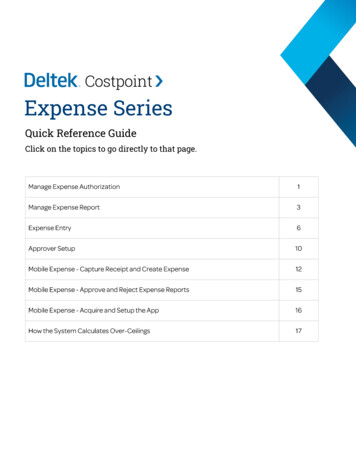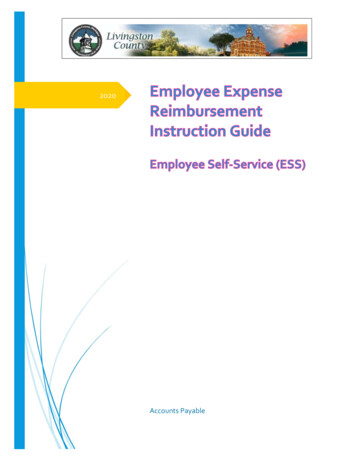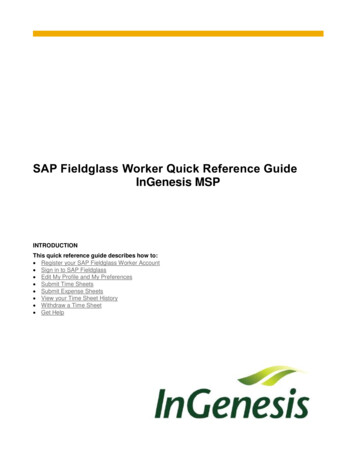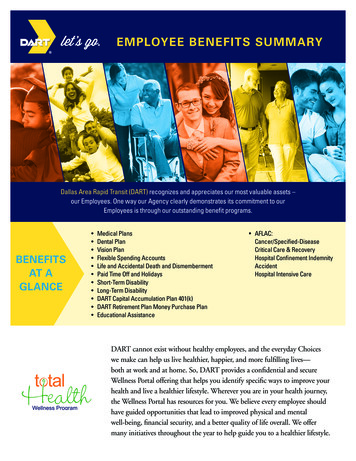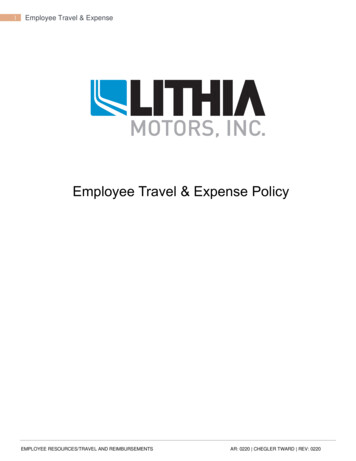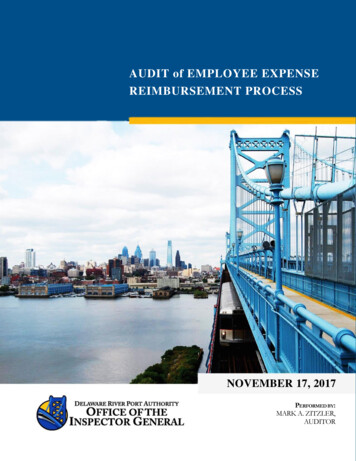
Transcription
AUDIT of EMPLOYEE EXPENSEREIMBURSEMENT PROCESSNOVEMBER 17, 2017PERFORMED BY:MARK A. ZITZLER,AUDITOR
One Port CenterPO Box 19492 Riverside DriveCamden, NJ 08101(856) 968-2000(856) 968-2001 Faxwww.drpa.orgOffice of the Inspector GeneralDavid J. Aubrey, CIA, CFEActing Inspector GeneralMEMORANDUMT O:J. White, CFOT. Brown, CAOO. Parker, Manager, Budget AdministrationK. Forbes, Director, HRSFROM:D. J. AubreySUBJECT:Audit of Employee Expense Reimbursement ProcessDATE:November 17, 2017The Office of the Inspector General (OIG) completed an audit of the Delaware River Port Authority’s(Authority’s) Employee Expense Reimbursement Process. The audit was performed by Mark Zitzler,Auditor. The audit objectives included: evaluating the effectiveness and efficiency of the employee expense reimbursementprocess and compliance with established policies, procedures, and guidelines;assuring employee expense reimbursement documentation / files are properly maintainedand retained;assuring requested reimbursements are accurate, approved, and paid / accounted forcorrectly;assuring requested reimbursement requests only reflect allowable and approved purchasetransactions, while evaluating transactions for potential fraud, waste and abuse;assessing any changes to the employee expense reimbursement process and controlenvironment resulting from the SAP ERP system implementation; and,evaluating the employee expense reimbursement process for any observable operationalimprovement opportunities.1The DRPA is an Equal Employment Opportunity Employer
The scope of analysis and testing focused on employee expense reimbursement activity fromJanuary 2014 through December 2016, with specific transactional testing focused on the year 2016.The universe of transactions provided included transactions associated with the Authority’s TuitionReimbursement Program, which were also assessed for compliance with Authority policy /procedure. Total reimbursed employee expenses (including tuition reimbursement) for the years2014 through 2016 was 234,357 (associated with 2,114 transactions).During the course of the audit OIG primarily interacted with the Manager, Budget (also ActingRevenue Director), Chief Financial Officer (CFO), Administrator, Employee Relations, Programs &Policies, Human Resource Services (HRS), as well as other HRS, Finance and Accounting managementand staff as necessary.Based on conversations with management, testing performed, and observations completed, theemployee expense reimbursement process (including reimbursement of tuition expenses) isfunctioning properly. Opportunities were identified to enhance the control environment andtransactional processing associated with the Employee Expense Reimbursement Process, andalternative processing recommendations were provided for management’s consideration. Insummary, based on the completion of our audit the following was determined and communicatedto the Chief Financial Officer (CFO) and Manager, Budget (where applicable, tuition reimbursementrelated findings and recommendations were communicated / discussed with the ChiefAdministration Officer (CAO), Director, Human Resources Services, and the Administrator, EmployeeRelations, Programs & Policies): the employee expense reimbursement process is operating effectively and efficiently, andcompliance with established policies, procedures, agreements, and guidelines wasconfirmed with minimal exception;reimbursed employee expense documentation and related files were properly maintainedand available;employee expense forms were accurate, approved, paid, and accounted for correctly;supporting documentation (i.e. invoices, receipts, etc.) reviewed reflected allowable andapproved purchase transactions. No transactions indicating fraud, waste or abuse wereobserved. Opportunities exist to improve the consistent documentation of approvedemployee expenses and the approval process performed by Authority management; and,changes to the employee expense reimbursement process and control environmentresulting from the recent SAP ERP system implementation were minimal, basically involvingthe improved method of electronically scanning and storing the employee expensedocumentation package with the associated transaction within the SAP system.Opportunities for improvement were noted during the audit and the following highlighted andsummarized findings were communicated: all identified transactions submitted during the year 2016 by Authority Commissioners,Executives, Chiefs, and Directors (99 transactions, 14,112.56), as well as all Finance andAccounting employee transactions (25 transactions, 2,008.51), were subject to review.No expense reimbursement requests were submitted by Authority Commissioners, and2The DRPA is an Equal Employment Opportunity Employer
all expense reports submitted by Executives, Chiefs, Directors, Finance and AccountingEmployees were deemed acceptable;all employee expense reimbursement transactions reviewed were supported by anemployee expense reimbursement report; however, 51 (25%) of the 207 transactionssampled for review did not have the employee expense reimbursement report attachedto the transaction within SAP;based on the 207 individual employee expense transactions reviewed, 193reimbursements (94%) were paid within 60 days from the point when the expense wasincurred; 76% (146) of those transactions paid within two months (193), werereimbursed to employees in 30 days or less;87% (180) of the 207 sampled and tested were accompanied by the proper supportingdocumentation; 20 transactions (9.7%) did not have receipts and an additional seventransactions (3.4%) did not have itemized receipts;travel expense and training travel costs represent over 50% of the Year 2016 employeeexpenses dollars reimbursed to employees, and 80% of the associated transactions. Ourtesting revealed instances where mileage related expense reimbursement transactionswere insufficiently documented to allow for appropriate recalculation and verificationof amounts submitted;twelve (86%) of the 14 Request for Education Reimbursement Program applications(iForm 029) tested were filled out properly and approved by their Chief / Director and /or Human Resources, but were not completed and approved before the course startedas required by procedure;three (10%) of 29 employees who received tuition reimbursement during the years 2014through 2016, have also left the Authority during years 2014 through 2016, and havenot paid back their tuition reimbursement to the Authority as required by policy /procedure. The Authority’s Tuition reimbursement policy / procedure stipulates a“claw-back” provision, if an employee receives tuition reimbursement and separatesfrom employment at the Authority within the following three years; and,Finance (Budget and Accounting) management should explore alternatives to thepresent employee expense payment process (including tuition reimbursement), such asimplementing the available technology to make employee expense payments directlythrough the payroll processing flow, and / or expanding the usage of the Authority’sPCard capabilities, making the expense processing more efficient and eliminating ordramatically reducing associated employee expense processing costs.These summarized findings and associated recommendations are presented in more detailwithin the report, along with management’s responses / corrective actions. The managementresponses were provided by J. White, Chief Financial Officer (CFO), with input from O. Parker,Manager, Budget Administration, and K. Forbes, Director, Human Resource Services, withconcurrence by T. Brown, Chief Administrations Officer.3The DRPA is an Equal Employment Opportunity Employer
OIG wishes to thank J. White, CFO, O. Parker, Manager, Budget, T. Brown, Chief AdministrationOfficer, K. Forbes, Director, Human Resource Services, and L. Ashley, Administrator, EmployeeRelations, Programs & Policies, as well as all Authority management and personnel whoparticipated in this audit for their cooperation during the engagement.cc:R. Boyer, Chairman, Board of CommissionersJ. Nash, Vice Chairman, Board of CommissionersE. DePasquale, Chairman, Audit CommitteeR. Taylor, Vice Chairman, Audit CommitteeV. Madden, Commissioner, Audit CommitteeA. Nelson, Commissioner, Audit CommitteeJ. Hanson, CEOR. Santarelli, General CounselL. Ashley, Administrator, Employee Relations, Programs & PoliciesM. Zitzler, Auditor4The DRPA is an Equal Employment Opportunity Employer
November 17, 2017DELAWARE RIVER PORT AUTHORITYOFFICE OF THE INSPECTOR GENERALAUDIT OF EMPLOYEE EXPENSE REIMBURSEMENT PROCESSA. Objective / Scope / MethodologyThe Office of the Inspector General (OIG) conducted an audit of the Delaware River Port Authority’s(Authority’s) Employee Expense Reimbursement Process. The audit was performed by Mark Zitzler,Auditor. The audit objectives included: evaluating the effectiveness and efficiency of the employee expense reimbursementprocess and compliance with established policies, procedures, and guidelines;assuring employee expense reimbursement documentation / files are properly maintainedand retained;assuring requested reimbursements are accurate, approved, and paid / accounted forcorrectly;assuring requested reimbursement requests only reflect allowable and approved purchasetransactions, while evaluating transactions for potential fraud, waste and abuse;assessing any changes to the employee expense reimbursement process and controlenvironment resulting from the SAP ERP system implementation; and,evaluating the employee expense reimbursement process for any observable operationalimprovement opportunities.The scope of analysis and testing focused on employee expense reimbursement activity fromJanuary 2014 through December 2016, with specific transactional testing focused on the year 2016.The universe of transactions provided included transactions associated with the Authority’s TuitionReimbursement Program, which were also assessed for compliance with Authority policy /procedure.To assist in the evaluation of the employee expense reimbursement process, OIG was providedaccess to requested information and documentation, including:1
transactional detail for employee expense reimbursements from January 2014 to December2016, which included:o 2016 transactions for the Authority and the Port Authority Transit Corporations(PATCO) from the current SAP ERP system; and,o 2014 and 2015 Authority and PATCO transactions from the former Banner andUNISYS systems, respectively.policies / procedures, which included:o Series No. 400, Expense Accounts, issued 2/20/04 and revised 11/21/12;o Series No. 123, Education Reimbursement Program, issued 10/15/09;o Series No. 124, Training, Business Seminars, Conferences, issued 8/7/97; and,o Expense Reports, Memberships and Subscriptions, Draft Policy and Procedure dated3/11/2016; and,list of 2014-2016 Education Reimbursements.In addition to being provided the documentation noted, OIG met with the Manager, Budget (alsoActing Revenue Director), Chief Financial Officer (CFO), Administrator, Employee Relations,Programs & Policies, Human Resource Services, as well as Finance and Accounting management andstaff during the course of the audit.B. BackgroundThe purpose of the employee expense reimbursement process is to allow employees to recover thecost of allowable business related expenses that were paid by the employee. According to theAuthority’s Expense Accounts procedure (Series No. 400), the Authority will pay for reasonablebusiness expenses incurred in the course of transacting official business where properdocumentation and/or approvals are submitted. When an employee incurs a business relatedexpense, they will complete a standard employee expense report form (electronic iForm). Thecompleted form and required supporting documentation is forwarded to the proper approvers anda check is cut and sent to the employee.Below are the annual amounts spent and transaction activity associated with Authority employeeexpense reimbursement per year for the years 2014 to 2016 (not including PATCO transactions):Year201620152014Grand Total Amount ( )34,712.9832,627.4924,666.1992,006.66# of Transactions7186475081,8732
PATCO employee expense reimbursement activity for the same timeframe is noted below:Year201620152014Grand Total Amount ( )4,960.637,117.592,976.8915,055.11# of Transactions354947131The universe of expense transactions paid directly to Authority employees also includesreimbursements for approved tuition expenses. Below are the annual amounts reimbursed andtransaction activity associated with the Authority’s tuition reimbursement program per year for theyears 2014 to 2016 (not including PATCO transactions):Year201620152014Grand Total Amount ( )34,510.0017,898.4820,668.2573,076.73# of Transactions18312473PATCO tuition reimbursement activity for the same timeframe is noted below:Year201620152014Grand Total Amount ( )20,098.1016,846.2517,282.7554,227.10# of Transactions13141037C. Audit SummaryBased on conversations with management, testing performed, and observations completed, theemployee expense reimbursement process (including reimbursement of tuition expenses) isfunctioning properly. Opportunities were identified to enhance the control environment andtransactional processing associated with the Employee Expense Reimbursement Process, andalternative processing recommendations were provided for management’s consideration. Insummary, based on the completion of our audit the following was determined and communicatedto the Chief Financial Officer (CFO) and Manager, Budget (where applicable, tuition reimbursementrelated findings and recommendations were discussed with the Chief Administration Officer (CAO),Director, Human Resources Services, and the Administrator, Employee Relations, Programs &Policies): the employee expense reimbursement process is operating effectively and efficiently, andcompliance with established policies, procedures, agreements, and guidelines wasconfirmed with minimal exception;3
reimbursed employee expense documentation and related files were properly maintainedand available;employee expense forms were accurate, approved and paid and accounted for correctly;supporting documentation (i.e. invoices, receipts, etc.) reviewed reflected allowable andapproved purchase transactions. No transactions indicating fraud, waste or abuse wereobserved. Opportunities exist to improve the consistent documentation of approvedemployee expenses and the approval process performed by Authority management; and,changes to the employee expense reimbursement process and control environmentresulting from the recent SAP ERP system implementation were minimal, basically involvingthe improved method of electronically scanning and storing the employee expensedocumentation package with the associated transaction within the SAP system.Opportunities for improvement were noted during the audit, and the following highlighted andsummarized findings were communicated: all identified transactions submitted during the year 2016 by Authority Commissioners,Executives, Chiefs, and Directors (99 transactions, 14,112.56), as well as all Finance andAccounting employee transactions (25 transactions, 2,008.51), were subject to review. Noexpense reimbursement requests were submitted by Authority Commissioners, and allexpense reports submitted by Executives, Chiefs, Directors, Finance and AccountingEmployees were deemed acceptable;all employee expense reimbursement transactions reviewed were supported by anemployee expense reimbursement report; however, 51 (25%) of the 207 transactionssampled for review did not have the employee expense reimbursement report attached tothe transaction within SAP;based on the 207 individual employee expense transactions reviewed, 193 reimbursements(94%) were paid within 60 days from the point when the expense was incurred; 76% (146)of those transactions paid within two months (193), were reimbursed to employees in 30days or less;87% (180) of the 207 sampled and tested were accompanied by the proper supportingdocumentation; 20 transactions (9.7%) did not have receipts and an additional seventransactions (3.4%) did not have itemized receipts;travel expense and training travel costs represent over 50% of the Year 2016 employeeexpenses dollars reimbursed to employees, and 80% of the associated transactions. Ourtesting revealed instances where mileage related expense reimbursement transactionswere insufficiently documented to allow for appropriate recalculation and verification ofamounts submitted;twelve (86%) of the 14 Request for Education Reimbursement Program applications (iForm029) tested were filled out properly and approved by their Chief / Director and / or HumanResources, but were not completed and approved before the course started as required byprocedure;4
three (10%) of 29 employees who received tuition reimbursement during the years 2014through 2016, have also left the Authority during years 2014 through 2016, and have notpaid back their tuition reimbursement to the Authority as required by policy / procedure.The Authority’s Tuition reimbursement policy / procedure stipulates a “claw-back”provision, if an employee receives tuition reimbursement and separates from employmentat the Authority within the following three years; and,Finance (Budget and Accounting) management should explore alternatives to the presentemployee expense payment process (including tuition reimbursement), such asimplementing the available technology to make employee expense payments directlythrough the payroll processing flow, and / or expanding the usage of the Authority’s PCardcapabilities, making the expense processing more efficient and eliminating or dramaticallyreducing associated employee expense processing costs.These summarized findings and associated recommendations are presented in more detail withinthe report, along with management’s responses / corrective actions. The management responseswere provided by J. White, Chief Financial Officer (CFO), with input from O. Parker, Manager, BudgetAdministration, and K. Forbes, Director, Human Resource Services, with concurrence by T. Brown,Chief Administrations Officer.D. Review of Policies / ProceduresThe following policies / procedures were reviewed during the audit, including the standardemployee expense reimbursement report form (electronic iForm):ooooSeries No. 400, Expense Accounts, issued 2/20/04 and revised 11/21/12;Series No. 123, Education Reimbursement Program, issued 10/15/09;Series No. 124, Training, Business Seminars, Conferences, issued 8/7/97; and,Expense Reports, Memberships and Subscriptions, Draft Policy and Procedure dated3/11/2016.The “Expense Reports, Memberships and Subscriptions, Draft Policy and Procedure dated3/11/2016” is in draft form and has not been implemented. This would be an additional policy /procedure to Series No. 400 and would include the approval process in SAP. Per the Manager,Budget, the “Expense Reports, Memberships and Subscriptions, Draft Policy and Procedure dated3/11/2016” policy / procedure will be reviewed in the future since there are other SAP issues thatare taking priority.In general, the policies / procedures were appropriately detailed and gave a clear description of theresponsibilities of all employee’s involved. Opportunities to improve the current policy / procedure,as well as to consider prior to implementation of the draft procedure, are presented in the findingsbelow:5
Audit Finding 1: Series 400 policy / procedure does not indicate who should review and approvea Chief level employee expense report.Audit Recommendation 1: Series 400 policy / procedure should be revised to include languagewhich defines who reviews and approves a Chief level employee expense report.Management’s Response 1: The CFO concurs with the finding and recommendation. Series 400does not address the approval hierarchy, just that approval is required. The reimbursementform requires approval by the Chief. It is inferred, using the chain-of-command, that the CEOwould approve all expense statements, and that an officer of the company will approve theCEOs.In practice, all Chief expense reports are to be viewed by the CFO to ensure there is a Chiefsignature. In the case of the CEO, either the Deputy CEO, or if absent, the CFO approves theCEO’s expense reimbursement form. The CFO will update policy (Series 400) to clearly indicatethe required approvals by March 31, 2018.E. Evaluation of Expense Reimbursement TrendsThe employee expense reimbursement transactional data from January 2016 to December 2016 wasextracted from SAP to allow OIG to analyze spending trends, such as highest amount spent per year/ month by employee, account/account description, and cost center.The transactional data was further examined for potential non-compliance with procedure, as wellas fraud, waste, and abuse. OIG also examined transactions for possible duplicate payments, credits,and unusual accounts. Employee expense data identifying specific employees was shared withAuthority management during the audit and at the completion (“close-out”) of the audit, and onlygeneral departmental identified data has been reflected within this report. Below are the tablesand charts that were used to help analyze the data and demonstrate the high users and usage ofemployee expense reimbursement activity:6
2016 EMPLOYEE EXPENSESTOP 5 AREAS - USAGE BY DOLLARSPATCO, 4,960.63, 13%Office of the General Counsel, 3,534.08, 9%Office of the CEO, 2,592.95, 7%Human Resource Services, 2,204.19, 6%Public Safety - Transit Unit, 2,046.8,5%Others, 24,334.96, 61%The highest dollar usage for employee expense reimbursement is associated with PATCO, Office ofGeneral Counsel, Office of the CEO, Human Resource Services, and Public Safety - Transit Unit.2016 EMPLOYEE EXPENSESTOP 5 AREAS - TRANSACTIONS VOLUMEToll - BFB, 141, 19%Toll - WWB, 115, 15%Office of the General Counsel, 56, 7%Toll - BRB, 56, 7%Human Resource Services, 42, 6%Others, 343, 46%The highest number of employee expense reimbursement transactions originate from the Tolls –BFB and Tolls – WWB areas of Bridge Operations. Although the transactions are high volume for thebridge areas, the dollar amounts per transaction are typically low on average since they areassociated with low dollar mileage reimbursements from traveling between Authority bridges.7
2016 EMPLOYEE EXPENSESTOP 5 EXPENSE ACCOUNT USGAE BY DOLLARSTravel Expenses, 15,255.44, 38%Training Travel Costs, 8,939.01, 23%Accounts Payable - InvoicesCONVERSION (Accruals), 2,960.19, 7%Meeting Expenses , 2,656.79, 7%Job Certifications & Licenses , 2,625.25, 7%Others, 7,236.93, 18%Travel expenses and training travel costs account for the majority (61%) of the total 2016 employeeexpense reimbursement costs.2016 EMPLOYEE EXPENSESTOP 5 EXPENSE ACCOUNT USAGE - TRANSACTION VOLUMETravel Expenses, 546, 73%Training Travel Costs , 53, 7%Accounts Payable - InvoicesCONVERSION, 37, 5%CDL License Fees, 33, 4%Meeting Expenses, 21, 3%Others, 63, 8%Based on our review of transaction volume, most employee expense reimbursements are submittedfor travel related expenses. Travel expenses and training travel make up 80% of the total 2016employee expenses submitted for reimbursement.8
2016 EMPLOYEE TUITION REIMBURSEMENT BY DEPARTMENTDepartmentPublic Safety /Emergency Mgt& HomelandSecurityPassengerServicesFleet Operations– WWB & CBBGovernmentRelationsCar EquipmentMaintenance MechanicalController &DataTrack & Right ofWayTotal# of# ofCompany Employees TransactionsTotal Reimbursed% of TotalAmountDRPA /PATCO1023 40,186.0074%PATCO23 6,042.0011%DRPA11 3,476.006%DRPA11 2,850.005%PATCO11 1,284.002%PATCO11 449.101%PATCO11 321.001%1731 54,608.10100%The table above reflects the Departments that participated in the Authority’s tuition reimbursementprogram and received tuition reimbursements during Year 2016. Public Safety / EmergencyManagement & Homeland Security had the most activity (in both participating employees and # oftransactions), as well as total tuition expenses reimbursed (74%).F. Compliance with Policies, Procedures, and Guidelines / InstructionsOIG obtained an understanding of the employee expense reimbursement process and controlenvironment from review of the associated policy / procedure and discussions with the BudgetingDepartment. To confirm effectiveness of the process and internal controls, OIG tested a sample oftransactions.The transactional data from January 2014 to December 2016 was extracted to allow OIG to analyzespending trends, such as highest amount spent per year by employee, account, and cost center. Thetransactional data was further examined for the potential for non-compliance with procedure, aswell as fraud, waste, and abuse; OIG also examined transactions for possible duplicate payments,credits, and unusual accounts.9
Based on evaluation of the spending trends and identification of unique transaction, OIG selected astratified sample of 207 transactions (26%) out of a total of 784 transactions for the period ofJanuary 2016 to December 2016. The total dollar value of the sample was 57,035.16, or 60% ofthe 94,281.71 total value of employee expenses reimbursed for the period of January 2016 toDecember 2016. To assure all areas of the Authority were evaluated for process compliance, at leastone transaction was sampled from each Department and each General Ledger Account. Higherreimbursed dollar amounts were considered for inclusion in our testing sample, as well as two credittransactions. Any identified transactions submitted by Authority Commissioners, Executives, Chiefs,and Directors transactions (99 transactions, 14,112.56), as well as all Finance and Accountingemployee transactions (25 transactions, 2,008.51), were also subject to review.It was noted that no purchases were made by Authority Commissioners. Additionally, all expensereports submitted by Executives, Chiefs, Directors, Finance, and Accounting Employees werereviewed and no unusual or unacceptable reimbursement requests were observed.Below is the sample distribution by sample selection description:DescriptionDRPA (Non-Tuition) AmountDRPA (Non-Tuition) # of transactionsPATCO (Non-Tuition) AmountPATCO (Non-Tuition) # of transactionsDRPA (Tuition) AmountDRPA (Tuition) # of transactionsPATCO (Tuition) AmountPATCO (Tuition) # of transactionsTotal AmountTotal # of transactionsPopulation 34,712.98718 4,960.6335 34,510.0018 20,098.1013 94,281.71784# of Samples 19,410.55170 4,297.5123 23,813.009 9,514.105 57,035.16207% of 8.46%60.49%26.40%Below is the sample distribution by Account:Account DescriptionTuition ReimbursementExpenseTravel ExpensesTraining Travel CostsAccounts Payable - InvoicesCONVERSION (Accruals)Meeting ExpensesJob Certifications & LicensesTraining Registration FeesAmount% Amountof Sample# ofTransactions% # ofTransactions 33,327.10 7,784.56 4,390.2858.43%13.65%7.70%14107166.76%51.69%7.73% .382,455.171,572.501,279.5010
Memberships & SubscriptionsCDL License FeesOther Training CostsMiscellaneous Expenses (i.e.staff meals during snow storm& handicap parkingreimbursement)Employee AwardsPostage ExpensesRental Expenses – OtherOther Grant ReceivablesUniform ExpenseOther Misc. EquipmentBridge Toll RevenueVehicle License feesSpecial EventsProfessional Fees - Legal Costs(travel charged to incorrectaccount)Total 1,105.75 715.05 468.091.94%1.25%0.82%61122.90%5.31%0.97% 208.74114.90111.5480.0073.6050.0036.0018.33 5.94 57,035.16The transactions were tested to ensure the employee expense reimbursement process program isoperating effectively and efficiently, and in compliance with the policy / procedure in force. Thetesting steps included: obtain copies of the i-Form employee expense reimbursement reports;verify the employee expense reimbursement report was submitted timely (within onemonth);ensure employee expense reimbursements are for the employee only;ensure all employee expense reimbursements are itemized;ensure descriptive travel codes are used for travel;ensure only the room charge, plus applicable taxes, are included in the Hotel column (andany overnight travel of Authority employees was approved in advance in writing by the CEOon the Overnight Travel – Request For Approval Form);ensure all employee expense reimbursements, except airline/ train tickets and meals, areincluded in the top section of the report;review reported mileage reimbursement to ensure that the current IRS rate per mile wasused to calculate the reimbursement amount;verify the individual signed the I-Form expense reimbursement report;verify the expense reimbursement report was approved by the appropriate member ofmanagement, as indicated by procedure and / or i-Form instructions;11
for all employee expense reimbursements reviewed, ensure the business purpose of theemployee expense reimbursements has been adequately explained and documented on theexpense report;ensure sales taxes are not paid;ensure employee expense reimbursements are charged to the proper account in theGeneral Ledger;ensure employees attending training have their employee reimbursement form approvedby the Chief Officer; and,compare employee expense reimbursement transactions to reported PCard expenseactivity for potential duplicate payments / reimbursement.Audit Finding 2: Per policy / procedure 400, the "Expense Report" form is to be used for thereimbursement of allowable employee expense reimbursements incurred and the settling ofcash advances. Although all employee expense reimbursement transactions reviewed weresuppor
changes to the employee expense reimbursement process and control environment resulting from the recent SAP ERP system implementation were minimal, basically involving the improved method of electronically scanning and storing the employee expense documentation package with the associated transaction within the SAP system.
